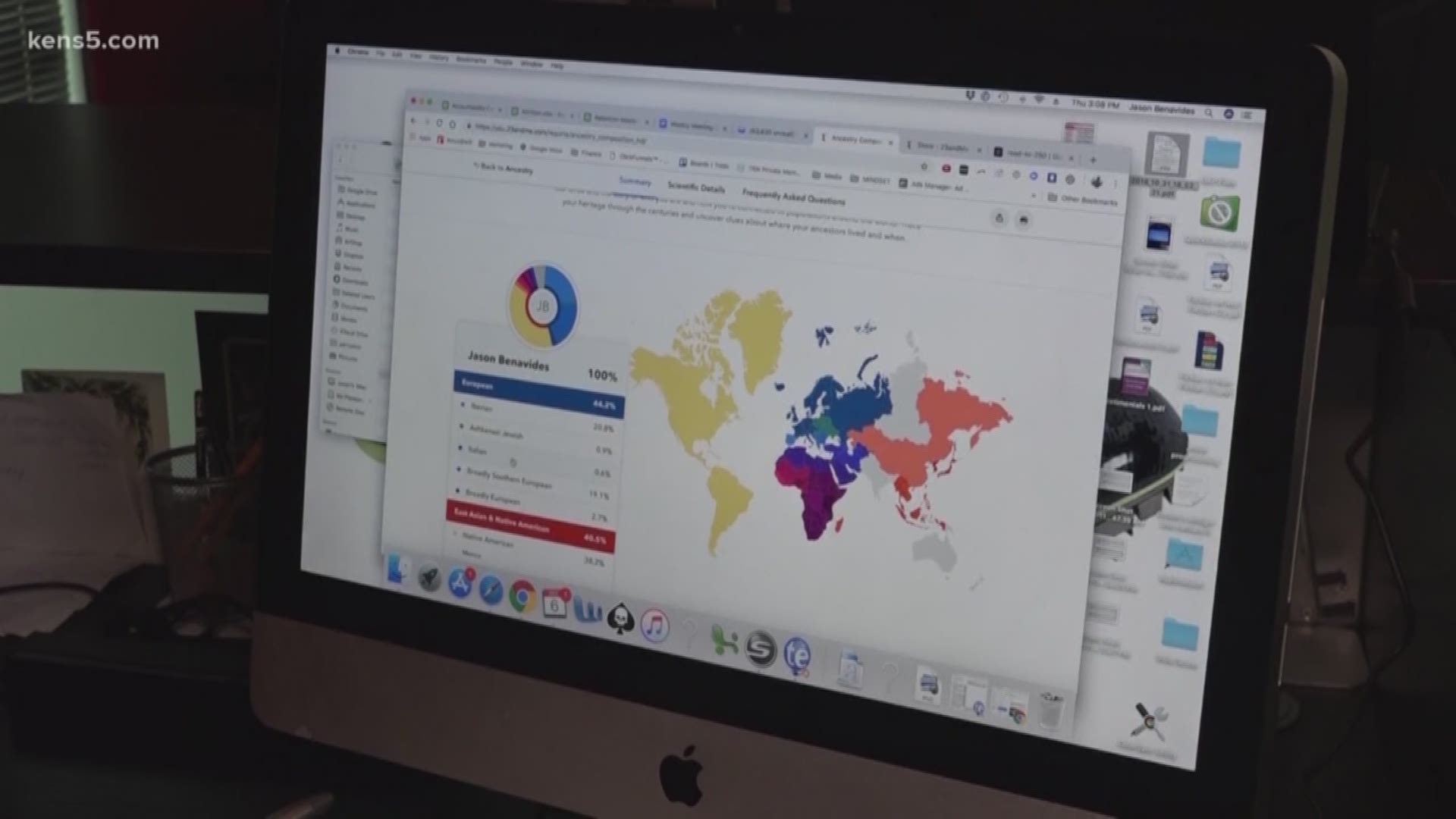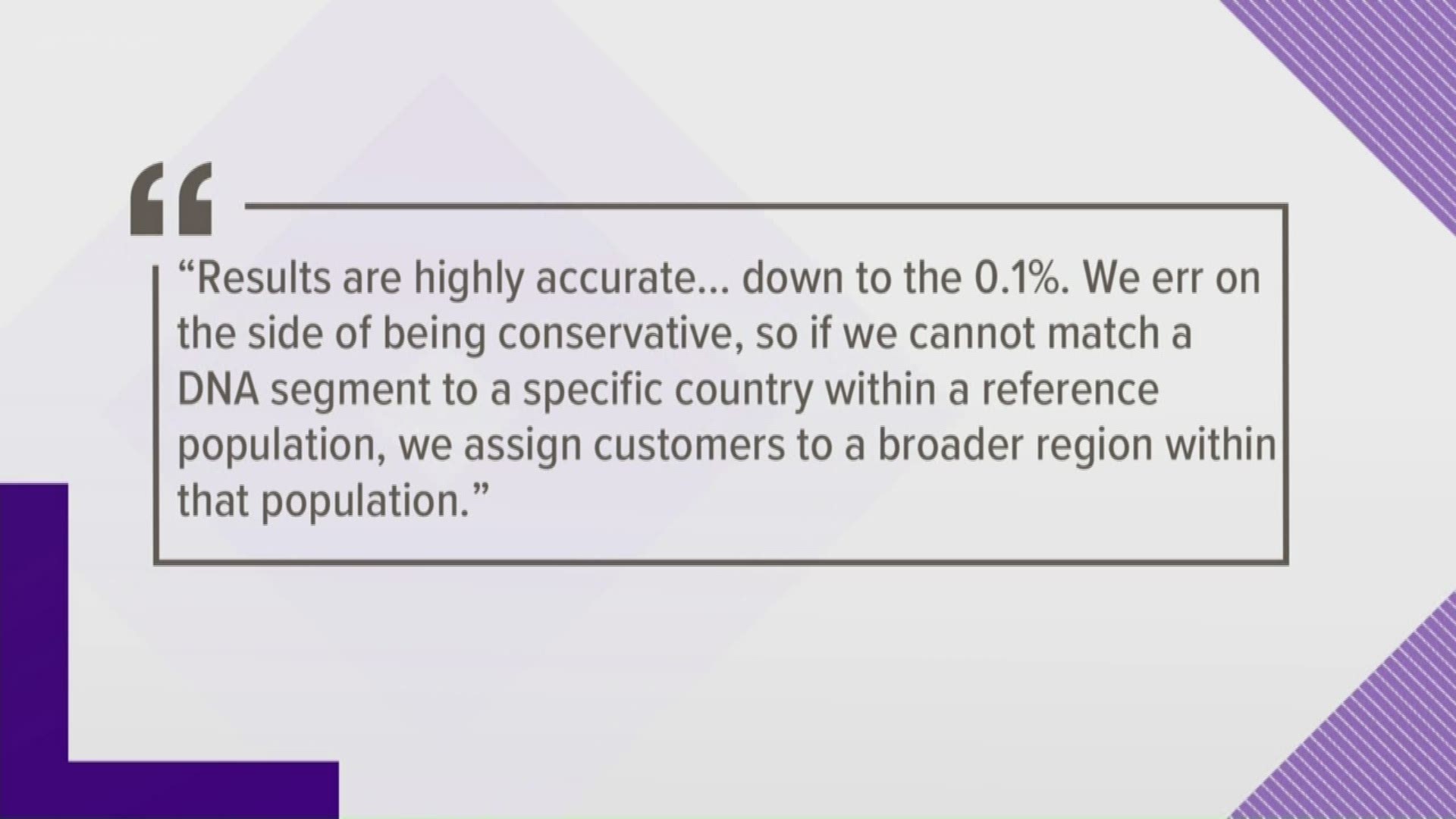SAN ANTONIO, Texas — After a busy holiday season, a popular ancestry information service announces 5 million people are registered in their database.
One of the DNA profiles is from KENS5 reporter Leah Durain, who tried out 23andMe's ancestry + health kit. To take the test, customers are advised to not eat or drink for 30 minutes before spitting into a tube and mail off the saliva.
Results are typically ready within a few weeks.
As far as Durain's lineage, she found she is 38.4 percent French and German, 31.9 percent British and Irish, and 2.5 percent Eastern European.
The rest of her ancestry was made up of portions from parts of Europe with 0.1 percent marked broadly West African.
With the upgraded kit, the results also show genetic health risks. Durain’s results indicated a slightly increased risk for Late-Onset Alzheimer's Disease and a variant detected for Age-Related Macular Degeneration, although without an increased risk for the disease. While nothing incredibly alarming, the results have Durain researching ways to strengthen her eye and brain health.
The health report was a big draw for Jason Benavides, a San Antonio gym owner who took the test about a year ago.
“My dad died when he was young with health complications,” Benavides said. “So I want to make sure...I just want to know more about my health, my history.”
Since getting his results, Benavides said he has relaxed about the things he can’t control and focused on things he can change.
“The biggest thing (is) just getting to know yourself more, which is kind of fun," he said. “I liked knowing about myself.”
As for the ancestry results, Spain and Portugal made up a large percentage of his history.
“The other, obvious portion to all my friends was Native American,” said Benavides, which he said accounted for his known Mexican heritage.
With millions of people looking into their ancestry, we turned to a licensed marriage and family therapist for insight into why so many of us care about where we come from.
“We know that our identities aren't our own individually,” said Becky Davenport, a licensed marriage and family therapist. “We are inherently connected to something bigger than ourselves; our families, our histories, our stories. That's what defines who we are and what our identity is.”
Davenport advised that if those considering an ancestry test are nervous the results may reveal family secrets, therapy is a way to work through any surprises.
While knowing more about your past may expand your identity, Davenport says, it doesn’t define all of you.
When learning about ancestry tests, the reliability of the tests and privacy concerns came into question.
We asked 23andMe about the reliability of their results, comparing their answer with the knowledge of a UTSA professor who specializes in cellular and molecular biology.
A spokesperson for 23andMe sent KENS5 the following:
"Both services 23andMe offers report highly accurate results to customers. On the health side, we proved through the FDA review process our ability to accurately call, or find, these variants with 99.9% accuracy when compared to Sanger sequencing results, the gold standard for accuracy.
In terms of our Ancestry Service, results are highly accurate, and we provide estimates of ancestry percentages down to the 0.1%. We also provide customers with the option to explore results with different confidence levels. Customers can select different confidence thresholds ranging from 50% to over 90% confidence. We err on the side of being conservative, so if we cannot match a DNA segment to a specific country within a reference population, we assign customers to a broader region within that population.
The percentage breakdown we provide in our Ancestry Composition report traces heritage back roughly 300-500 years and is highly accurate. The more ancient ancestry, dating back tens of thousands of years, is related to maternal and paternal haplogroups - groups of common ancestors that existed before mass migration of the human population. Our tracing of customers' heritage to these groups is backed by incredibly sound science, using Y chromosome and mitochondrial DNA that goes relatively unchanged from generation to generation, therefore allows a look back through many generations. These results are also based on published research. Our Neanderthal report, for example, cites a dozen peer-reviewed, published studies backing the science involved in the results, and our haplogroup reports cite literally hundreds of published scientific sources. For more please see this blog post.We break our entire product down here in a published white paper, for further information: see here."
UTSA Professor John McCarrey, Ph.D., said he did not have enough information to comment on the methodology used by the company but offered this insight:
“That’s an interesting question but I’m not sure I can provide a definitive answer. I understand the basics of how the 23andMe kit works, but not all of the specifics. They recover DNA from the cheek cells a person provides and then they analyze portions of the genomic sequence from each person’s DNA and they compare that sequence data to certain standard reference sequences. I don’t know how specific those standards are with respect to their representation of either a specific region of origin or ethnicity of origin. I believe they use a combination of DNA reference sequences from what we call “micro-satellite” regions of the genome which are highly variable and therefore more specific to individual groups or families, as well as DNA reference sequences from various specific genes that have particular relevance to specific traits such as height, eye color, hair color, disease susceptibility, etc.
According to their website, they don’t actually directly sequence the DNA which is what we would typically do in the lab because it is more precise (but also more expensive). Rather, they “hybridize” the person’s DNA to what is called a “microarray” that carries many little pieces of DNA of known sequence. When the sequence of the person’s DNA matches that of one of the reference DNA pieces on the microarray, then the person’s DNA sticks to that spot on the microarray indicating the person’s DNA carries the same bit of sequence as that in the small reference DNA piece on the microarray. That technology is fairly well developed now and should be fairly reliable – though in the research world it has already become largely obsolete and has been replaced by direct sequencing which is even more accurate. Again, the newer sequencing technology (known as “next-generation” or “next-gen” sequencing) is more expensive than the microarray approach, but it also yields more information.
All of that doesn’t directly answer the question asked by Ms. Durain, but the specific answer to her question comes down to how accurately the various patterns of matches or lack of matches between a person’s DNA and the reference pieces of DNA on the microarray can faithfully and accurately predict the region(s) of origin of that person’s ancestors. Unfortunately, I do not know the extent of accuracy of the predictive power of that methodology."
Another common question is about the company sharing results with research companies. When you set up your profile with 23andMe, the company asks for your consent, and there is the chance to opt out. Once your account is activated, you can change your consent in the settings tab at any time.
You can also ask the company to store your sample or to discard the saliva.


